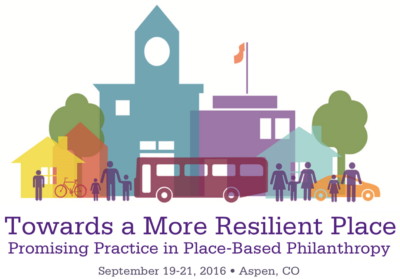
By Raquel Gutierrez, Vitalyst Health Foundation
In September, the Aspen Institute Forum for Community Solutions and Neighborhood Funders Group convened 100 local, regional, and national funders for Towards a More Resilient Place: Promising Practices in Place-Based Philanthropy. Here, Raquel Gutierrez of Vitalyst Health Foundation reflects on where the culture in foundations needs to evolve to match developments in the field.
 |
The Aspen Forum for Community Solutions and Neighborhood Funders Group chose an inspiring setting for their convening, Towards a More Resilient Place: Promising Practices in Place-Based Philanthropy, earlier this fall. The shimmering leaves on tall aspens graced the mountains that surrounded us, enveloping us in a blanket of gold and a myriad of green pines. There was a quiet there that settled my restless mind. The altitude reminded me to breathe deep. There is a calming simplicity in the art, architecture and landscaping that define the Aspen Institute.
In many ways, the conference matched our surroundings. Outside of logistics and agenda building, the approach was simple, tried and true: Bring people together from across the country who are passionate about justice and social transformation, and provide opportunities to share, listen, reflect, and share some more. The opportunity to listen and learn about strategies from other funders and nonprofit leaders was a gift; it will inform how I approach my portfolio and will influence Vitalyst Health Foundation’s journey specific to equity and approaches grounded in democratizing development.
Reflecting Our Values Through Action
The opening plenary, Community Power Building as Community Resiliency, has stuck with me even weeks later. The opportunity to hear emerging leaders in philanthropy share their experience—frustrations and all—illustrated how they are changing the practices and world-views that have historically dictated philanthropy. Their forthrightness about cultivating relationships with folks in the community while navigating the transformation of implicit biases that exist within their foundations’ practices resonated with my experiences. While the presenters remarked, “I hope I still have a job after this panel,” I thought, “If we can’t have these conversations here, where can we?” As someone who has only worked in philanthropy for four years, it was refreshing to have colleagues speak truthfully about their struggle to work with the norms that make up the culture of their respective foundations, while simultaneously trying to change these internal practices and use approaches that can better reflect their values in action.
The Community Changing the Rules: The Role of Residents to Influence Policy session reaffirmed Vitalyst Health Foundation’s move to support community organizing and capacity building of social justice oriented organizations. For example, it was significant to hear folks make the connection between Freddie Gray’s life and the conditions which lead to his death. I was able to bring back questions such as, “Where can someone fall through the cracks? How do we cultivate and support residents to formulate and drive their own health policy agendas? What data do residents need to create their agendas, and are we willing to fund that work?” I left with a deep desire to better understand democratic development and with a higher level of commitment to my role in Neighborhood Funders Group’s Democratizing Development Program.
Growing Edges of the Place-Based Community Change Movement
There is a tide of change in philanthropy that felt very present at the convening, particularly as it relates to passing the torch to an emerging set of leaders. Some of it was typical generational shift anxiety, but there was an extra ingredient of overall openness to risk taking that felt palpable, particularly among the emerging philanthropists. Some seasoned funders were in a reflective mood about how much more is possible. They asked, “Shouldn’t our efforts have had more impact?” and “What could we have done differently?”, without solely blaming nonprofits or community leaders for the lack of impact. The idea that grantmakers are thinking about what role they played in the lack of impact could develop into something significant. I was also encouraged by people’s commitment to resident engagement that puts the philanthropist in a supporter and learner role, rather than sole designer and driver of initiatives.
Finally, another indicator of how philanthropic culture is changing comes from the many comments of gratitude for inviting convening participants from communities directly involved with a foundation’s work. I was honored to have Joseph Larios, a resident in one of the communities Vitalyst Health Foundation works in and a member of our Board of Trustees, represent the innovative work of his community in such a dignified way, sharing the meaningful and important work happening in Arizona. The Towards a More Resilient Place convening showed me how a growing cadre of leaders is embracing this growing edge that will be critical for strengthening communities in the future.